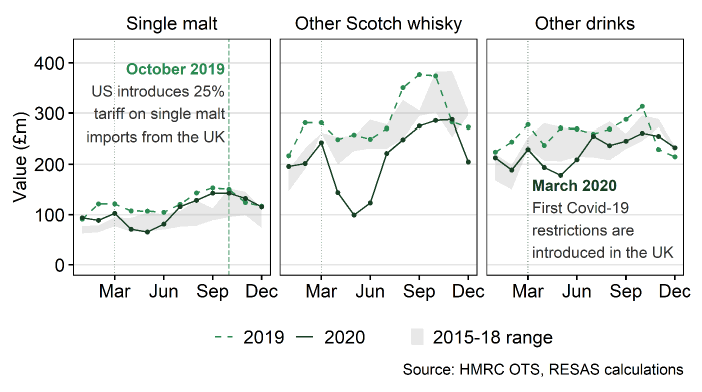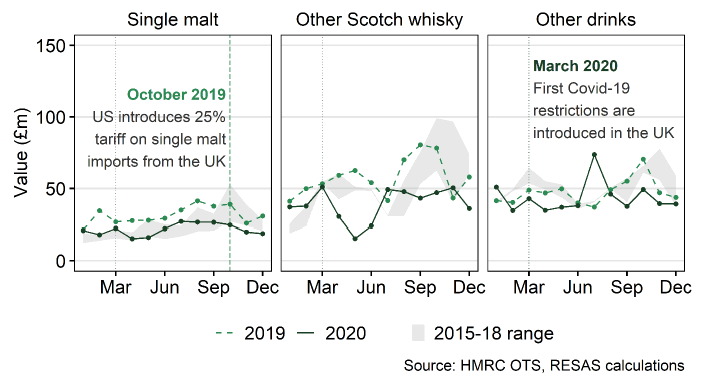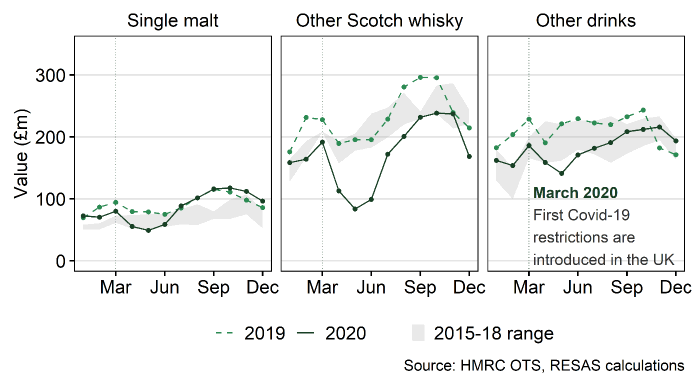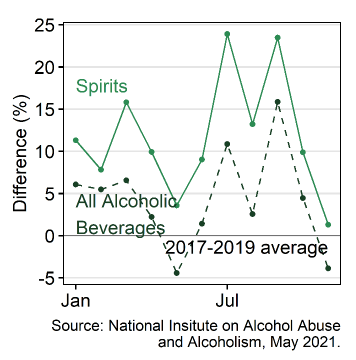Estimating the impacts of US tariffs on UK exports of single malt Scotch whisky
This discussion paper aims to estimate the impact of US tariffs on UK exports of single malt Scotch whisky between Q4 2019 – Q4 2020 using the novel synthetic control method.
1 Introduction
1.1 US Tariffs
In October 2019, the US government imposed a 25% tariff on single malt Scotch whisky (hereafter 'single malt') imports from the UK. Before this, no tariff was in place. The background to these tariffs is explained in Box 1 below.
The tariff on single malt is imposed on the HTS[1] commodity code 2208.30.30 (single malt Irish and Scotch Whiskies); this is the reason why both Scotch and Irish single malt whiskies exported from the UK are subject to the tariff.
The increase in import cost is not reflected in the export value reported by HMRC. However, some transport costs are included in the export value.[2] Changes in the export value of single malt would primarily stem from changes in the average price or quantity.
1.2 Scotch Whisky Exports
The impacts of these agri-food tariffs on exports of single malt to the US are particularly of interest because (i) Scotch whisky has historically been a major UK agri-food export, and (ii) the United States is the single largest destination of UK Scotch whisky exports on a per-country-basis. This is demonstrated by the 2018 export values for Scotch whisky (the last full year before the introduction of US tariffs) in Table 1.
| Destination Ranked by single malt export value |
All Drinks* |
of which… Scotch Whisky |
of which… Single Malt |
|||||
|---|---|---|---|---|---|---|---|---|
| Value | Value | Volume | Price | Value | Volume | Price | ||
| £m | £m | mLPA** | £/LPA | £m | mLPA | £/LPA | ||
| 1 | United States | 1,622 | 1,039 | 38.3 | 27.13 | 344 | 6.9 | 49.92 |
| 2 | France | 623 | 437 | 52.1 | 8.39 | 164 | 5.6 | 29.52 |
| 3 | Taiwan | 184 | 168 | 12.1 | 32.94 | 101 | 2.3 | 44.08 |
| 4 | Germany | 334 | 177 | 13.2 | 13.43 | 97 | 2.6 | 37.41 |
| 5 | Singapore | 365 | 320 | 5.5 | 25.65 | 83 | 2.7 | 30.82 |
| Rest of world | 4,661 | 2,570 | 238.0 | 10.80 | 516 | 14.5 | 35.51 | |
| Total | 7,789 | 4,712 | 359.2 | 13.12 | 1,306 | 34.6 | 37.75 | |
* 'All Drinks' is classed as HS2 Chapter 22 (beverages, spirits and vinegar) excluding 2209 (vinegar), where Scotch whiskies are relevant CN8 codes within 22. ** Millions of litres of pure alcohol. Source: HMRC Overseas Trade Statistics, February 2021.
In 2018, UK exports of Scotch whisky to the US were valued at just over £1 billion, more than a fifth of total overseas Scotch whisky exports, and 64% of all UK drink exports to the US. In total, the UK exported £4.7 billion worth of Scotch whisky, three-fifths of total drink exports the same year. Single malt accounted for 28% of total Scotch whisky exports, and 33% of total Scotch whisky exports to the US.
1.3 Covid-19
Measuring the impact of the US tariffs on exports of single malt is complicated by the fact that UK drinks exports have generally seen major decreases in export value (and volume) throughout 2020 – likely as a result of Covid-19 (i.e. restrictions on hospitality sectors across the globe). This is true for most countries, including the United States. Other regions, particularly the EU, have also seen fluctuations in export value during 2019-2020, e.g. with relation to EU Exit.
Scotch whisky as a whole also seems to have been impacted more drastically than other drinks, as shown in Figure 1 below, with a large negative impact seen especially in non-single malt in early- and mid-2020.
Between April-October 2020, a period in which many countries experienced varying levels of Covid-19 restrictions, exports of Scotch whisky and other drinks were below or on par with the 2019 value. However, exports of single malt were not nearly as badly impacted: the initial 'shock' is smaller in magnitude, and the monthly export value since August 2020 has been close to 2019 values.

Looking at the time series in Figure 2, this worldwide Covid-19-related shock in early and mid-2020 seems to have impacted Scotch whisky exports to the US as well (similarly to world exports, exports of single malt to the US did not see as large of an initial shock). However, they have consistently been below 2019 values throughout 2020 – this is in contrast to single malt exports to the world, which returned to near-2019 values in the latter half of 2020.

Figure 3 shows the same three exports over 2019-20 to non-US countries (essentially Figure 1 minus Figure 2). Single malt exports to the rest of the world recovered to their 2019 levels in July 2020 and even exceeded them for the remainder of the year. This suggests that demand for (single malt) Scotch whisky was dampened in the US compared to other export destinations. This could be due to the tariff, but it could also be due to other factors – e.g. US-specific restrictions on hospitality sectors during the latter half of 2020.

1.4 US Demand for Scotch Whisky
1.4.1 US Consumption Patterns
There is some evidence that the Covid-19 pandemic during 2020 may have increased the consumption of alcohol for Americans – this could be due to increased stress, increased alcohol availability, or boredom.[3],[4] However, research is still ongoing, and some have found evidence of the contrary, while highlighting that a proportion of the population have indeed seen increases in alcohol consumption.[5]
Data from the National Institute of Alcohol Abuse and Alcoholism[6] suggests per-capita consumption of spirits was higher than the 2017-2019 average throughout 2020, with particularly large differences during Jul-Sep 2020. This is shown in Figure 4.

1.4.2 Scotch Whisky Sales
Data from the IWSR suggests that retail sales of Scotch whisky in the US (including both on-trade and off-trade) decreased between 2019 and 2020 (a 1.5% decrease in volume, and a 3.1% decrease in value).
Decreases of this magnitude (or larger) were not unheard of in other countries – total global sales of Scotch whisky declined by 3.8% in terms of quantity (excluding travel retail sales). When taking into account these travel retail (duty free) sales, this global decrease was more pronounced at 9.5%. The global reduction in travel during 2020 will also have contributed to the decrease in exports of Scotch whisky to the US.
| Category | Year | Volume millions of 9-litre cases | Value $ billions |
|---|---|---|---|
| Scotch whisky |
2019 | 8.51 | 3.47 |
| 2020 | 8.38 | 3.36 | |
| Change (%) | -1.5 | -3.1 | |
| All whisk(e)y |
2019 | 74.77 | 19.90 |
| 2020 | 78.40 | 21.16 | |
| Change (%) | +4.9 | +6.4 |
Source: IWSR Drinks Market Analysis Ltd. (via the Scotch Whisky Association)
Many countries saw an increase in Scotch whisky sales between 2019 and 2020, largely driven by increases in off-trade sales. While the US saw a moderate 6.3% increase in off-trade sales, countries like the UK, Japan, Australia, and the Netherlands all saw double-digit growth.
It is also worth noting that US sales of all whisky/whiskey increased in quantity (+4.9%), as did sales of all spirits (+4.6%). This suggests at least some or all of the non-Scotch whisky varieties (e.g. US or Canadian whiskeys) increased in quantity, enough to offset the decreases in Scotch whisky retail sales. This total increase was again driven by increases in off-trade sales (+15.7% in terms of volume), enough to offset the 45.1% decrease in the volume of on-trade whisky sales.
1.5 Economic Theory
1.5.1 Elasticity
Economic theory dictates that, usually, an increase in import costs (for example due to the introduction or increase of an ad valorem tariff) for some good should decrease the quantity demanded for that import in a given country. The magnitude of that decrease depends on the way consumers, exporters, and importers react to a price change, and the timescale of these changes can differ as well. This magnitude, and its direction, is referred to as a price elasticity. A variety of different elasticities may come into play – for example:
1. Price elasticity of demand – this is a measure of how consumers' demand for good changes as the price for good changes. For example, a 25% increase in retail price may only result in a 20% decrease in quantity demanded – some consumers may be willing and able to pay the higher price.
2. Import price elasticity of demand (or elasticity of substitution) – a measure of how importers or consumers react to a change in the prices of imported good . For example, an increase in the price of imported single malt may prompt some domestic consumers to switch to other foreign imports or domestically produced substitutes (e.g. Irish whiskey or American Bourbon).
3. Income elasticity of demand – usually, import and export quantities are sensitive to changes in income domestically and abroad, respectively. A decrease in income domestically may reduce demand for imports.[7]
A key assumption with any elasticity is that everything except the change in price stays the same. For example, when there is a simultaneous change in price of two substitute goods and (e.g. whisky and gin), estimating the price elasticity of good will be more difficult. This may also require controlling for any external factors affecting the demand of good (not just the prices of goods and ).
For that reason, estimating the import elasticity for single malt by only looking at changes in single malt export price and quantity will have its limitations. While some external factors can be accounted for (e.g. an overall decrease in consumption due to Covid-19), others cannot: taking into account changes in prices and quantities of other drinks, whether they are produced in the US or imported, would require modelling techniques outside the scope of this analysis.
1.5.2 Determinants of Trade
There is a vast and longstanding literature on finding determinants of trade. These could be used in estimating aggregate trade flows or controlling for external factors in elasticity estimations. One example of such an approach is Tinbergen's so-called gravity model of trade (1962), which has since been widely used (and improved) since its introduction.[8] Chaney (2018) gives a comprehensive overview of the gravity model, and its empirical validity, in international trade.[9]
A simple gravity model essentially boils down to the following:
- 1. Larger economies tend to trade more with one another
- 2. Economies which are closer together tend to trade more with one another
Although the role of an economy's size (GDP) is well-understood and has theoretical underpinnings, the role of distance is less understood. Despite this, the relationship has proven stable over time and across studies.
Chaney (2018) suggests that distance may actually be a well-behaved proxy for the cost of creating contacts (i.e. between suppliers and customers). He argues that although distance alone may not be enough to explain an individual firm's exports at any given time (i.e. transport and communication technologies and the political environment matter), it may be sufficient to explain trade in the aggregate.
Since we are interested in the trade of a single good (single malt) as opposed to the sum of hundreds or thousands of goods, these aggregate determinants may hold less relevance. Instead, sector-specific determinants may be more relevant (e.g. alcohol consumption). There may also be more inherent volatility and less stability in the relationships between these determinants and observed trade flows of a single good.
Contact
Email: agric.stats@gov.scot
There is a problem
Thanks for your feedback